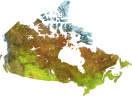|

|

Forest Fire Facts and Questions
General facts about forest fires in Canada
- The number and distribution of forest fires and area burned varies
annually across Canada.
- Although fire statistics go back to the 1920s, Canadian statistics
before 1970 are considered incomplete.
- Provincial and territorial fire agencies are responsible for fire-suppression
activities.
- The Canadian Interagency Forest Fire
Centre (CIFFC) provides operational fire-control services and links
to all provincial and territorial fire agencies.
- Fire occurrence and area burned is highly variable
- Area burned ranges from 0.7 million to 7.6 million ha/year.
- Average area burned is 2.5 million ha/year.
- Average fire occurrence is 8000 fires/year.
- Average suppression costs are $300 million to $500 million annually.
- Lightning fires
- Represent 45% of all fires.
- Represent 81% of total area burned.
- Occur in remote locations and often in multiple clusters.
- Human-caused fires
- Occur in more populated areas and are usually reported quickly.
- Fire size
- 3% of fires are greater than 200 ha.
- Fires greater than 200 ha represent 97% of area burned.
Large Fire Database (LFDB)
Fire Suppression and Level of Protection
- Fire suppression is a provincial responsibility.
- The level of protection varies across Canada and within provinces.
- Key issues in the discussion of fire suppression and level of protection
relate to the use natural fire versus the role of protecting the forest.
Boreal Fire Characteristics
- In the boreal forest, large fires dominate the area burned.
- Large fires are a natural and essential part of the boreal forest
ecosystem.
- Large fires have played a major role in forming and maintaining the
boreal forest.
- Large fires have high fuel consumption and rates of fire spread.
- Extremely high rates of sustained energy release are common.
- Towering convection columns can reach into the upper troposphere or
stratosphere.
- Long-range smoke transport is an issue.
Circumboreal Fire Characteristics
- Boreal forest is located primarily in Canada, Russia, and Alaska.
- Annual area burned is 5 million to 15 million ha.
- Crown fires are typical in North America.
- Surface fires are typical in Russia.
- Fires are natural and essential to boreal ecosystems.
- Russian statistics are underestimated.
- Area burned shows great interannual variability.
- Key issues are continental climate, extreme weather, multiple ignitions.
|